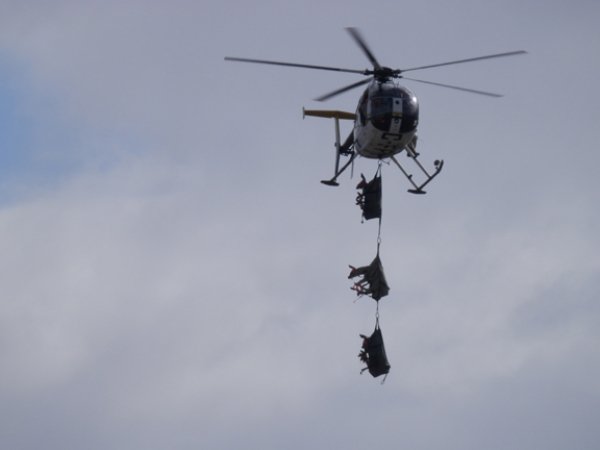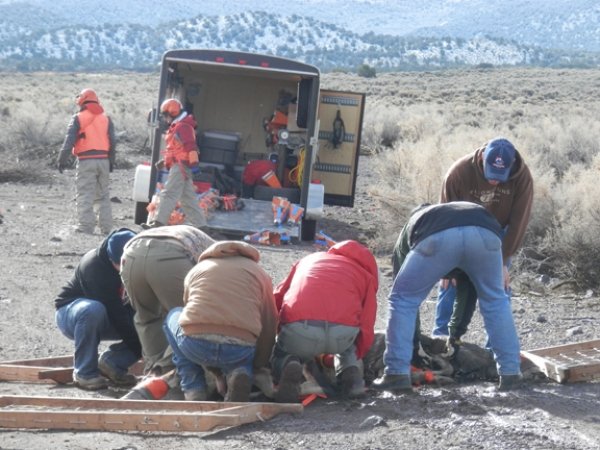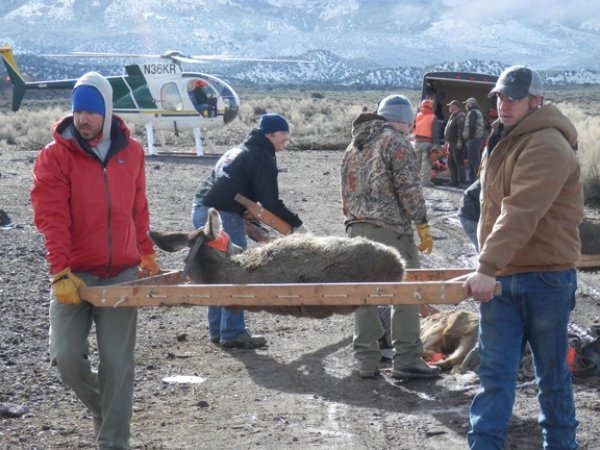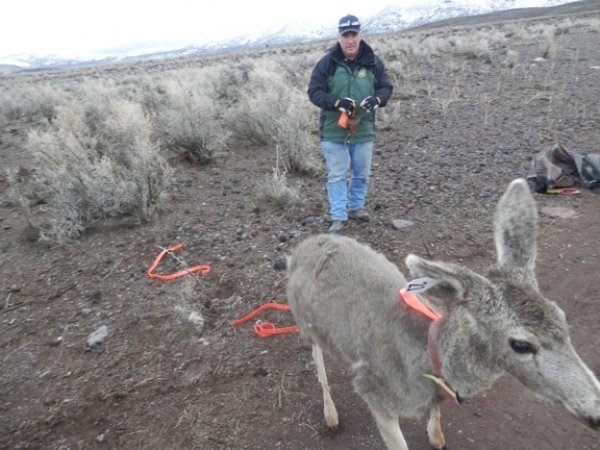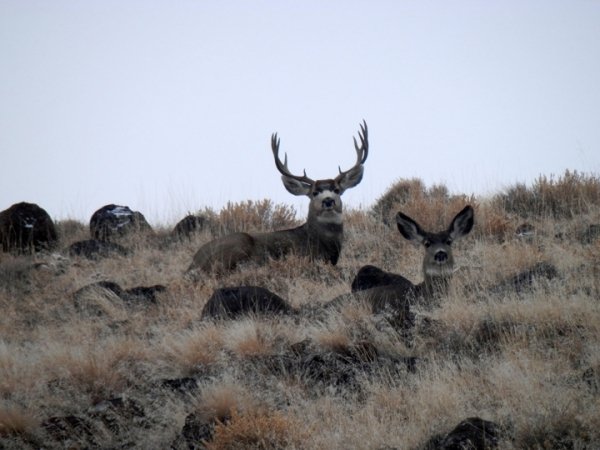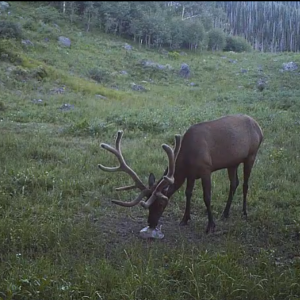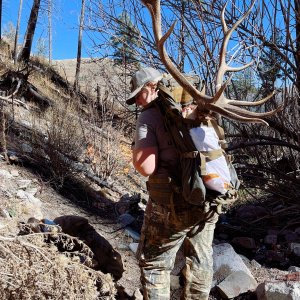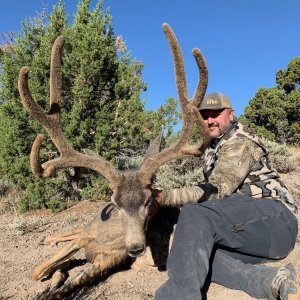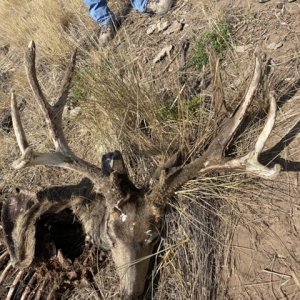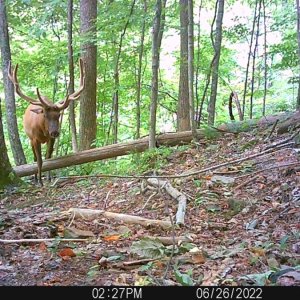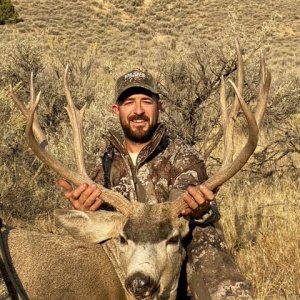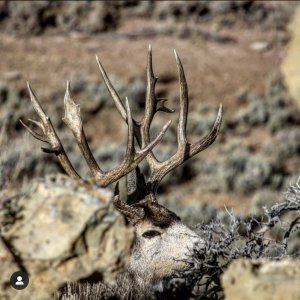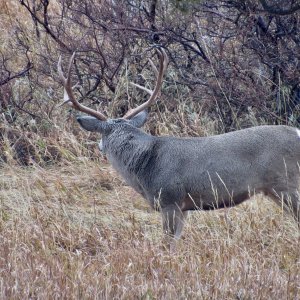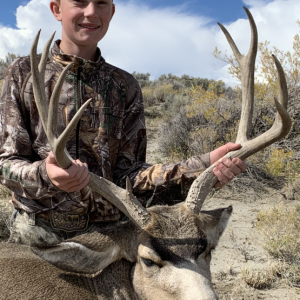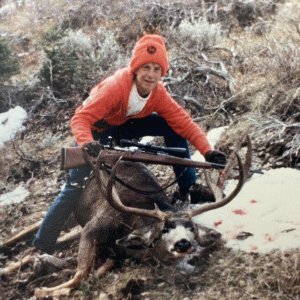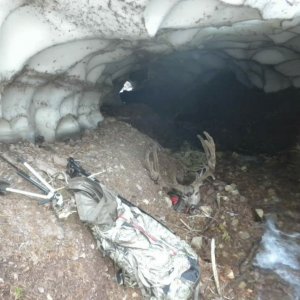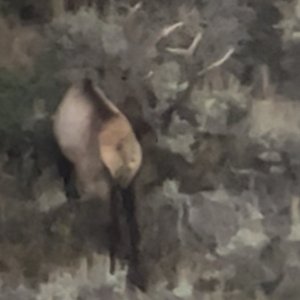Fair enough STM. Thank you.
Now the typical MMer isn't going fight his way through this. and who can blame him, but STM, you're not typical, so I know you will.
Regarding your inquiry as to my unusual request for about yourself. I believe you spelled it out, to a great degree, in your following statement:
"Over the years I have conversed with many scholars in the wildlife field, and have been known to drive a few hundred miles to speak to them in person, rather than on the phone so I could look in their eyes and read the sincerity on their face."
You also said to me, in a previous post: "I would be very interested in your observations of your part of Utah over the last few decades, do tell..."
This you asked, after you seemed to suggest that people like myself, who are not looking into the "complete picture" are not therefore, discerning an accurate reality of the problems and the solutions to the decline the mule deer, that you and I are both passionate about.
I concluded, from your remarks, that you believe I am interpreting what I have observed inaccurately or at least too shallowly, so I wished to know what kind of person I was preparing to defend my observations and believes too. That's way I asked for your back ground.
Like yourself, I'm fairly serious about the kind of world we live in, founded and dependent on the outdoors and the wild species that inhabitant it, especially mule deer.
Second, I believe North American Deer are the most important big game species we have and what ever it takes to preserve them, in abundance, for the purpose of sport hunting is the most important hunting conservation effort that we can be engaged in. Here's why. I'll stick to mule deer but the white tail is just as important, in it's environment.
Deer are the lynch pin to big game hunting because:
You can feed 4 or 5 deer on the same pounds of feed than you can one elk or one moose.
Deer are prolific, you can, under favorable conditions, explode the number of a passive population into a large surplus population, in a very few years.
Deer are not herd animals, they live in small and dispersed family groups, spread from the highest elevations to the river bottoms. You can find them anywhere snow depth allows them to find feed.
Deer can be managed around stack yards, fences, and agriculture much easier than elk, for far less expense.
Sixteen year old hunters with clunker cars, without the assistance of adults, without horses, pickup trucks, atv's or expensive equipment can hunt them successfully and carry them from the deepest hole, or the furtherest peak, with a simple back pack.
Deer can be harvested and their meat returned safely to camp, without waste, on the hots days of autumn or the coldest days of December, by foot, regardless of age or strength.
Older men and old women still can hunt deer, harvest them, and care for the meat, into their 80's.
I believe (this is a personal thing, I'm sure) deer meat tastes better than elk and antelope.
Deer can be hunted, without waste, with the least expensive 30-30 to the most expensive .300 WinMag., 45 Cal muzzleloader, or 45# long bow.
Deer leather makes superior clothing.
Deer antlers configurations are unpredictable and have equal if not greater aesthetic value most other big game species. (This again maybe a person preference, but others have expressed a similar preference.) You never know what a mature buck will grow to look like, elk, antelope and moose are highly predictable, accept for total inches of size.
Deer can live in close proximity to humans, and even thrive in the largest, dirtiest, busiest cities on the continent. I've personally seen deer within a hundred yards of the Golden gate bridge in down town San Francisco.
I'm not one that believes all species are equal in the universe. I understand the need for snails and plankton, in the big picture, but I believe deer have more value to humans that sewer rats. I believe if we maintain an environment that supports healthy deer (and all wild ungulates), every other species, beneath them in the soil and above them in the air, will be health as well. So.....we should work to make sure we have thriving deer herds and it will draw up everything else with it.
Someone smarter than me needs to write a book on why deer are the key to preserving and propagating all wildlife and the outdoor hunting life style, associate with deer.
What have I observed about deer in the last four decades, on a small scale, in my back yards.
40 years ago professionals and non-professions believed you could never get rid of the deer, they said, "they were like flies, you kill them of and the next year they're all right back".
The worst winter south central Utah every recorded was 1949-1950. The following decade, the 1950's, was the greatest deer hunting decade in the recorded history of the area.
The spring of 1983, due to winter snow pac, (from the top of the mtns. to the bottom of the valleys) we witnessed the worst flooding south central Utah had seen in modern history. Sevier Valley was a lake, 35 miles long, 6 miles wide and 18 feet deep, measured from the top of the lake to the bottom of the Sevier River. The water shed area (the snow pac area) goes from just north of Glendale to Salina, a distrance of more than 135 miles. The snow pac stayed in the mountains until June (winter forage for deer was buried under snow until far past the normal green up. A huge winter die off of deer was predicted, yet the next fall, in 1983, when there should not have been hardly any yearling bucks left, Utah harvested 82,552 bucks, the largest number of bucks ever killed in any single year in the State's recorded history. The next 5 years, when all of the deer that should have died from the 1983 winter kill, produced some of the highest numbers of bucks harvested, for any sequence of years in the history of the State. 63,000, 59,000, 60,000, 65,000, 68,000 bucks killed.
Prior to 1980, we targeted very few specific antlerless deer in the south central Utah area .(we held "Any Deer " hunts in the 50s and 60's and archery "Hunter's Choice permits) Then.....from 1980 through 1993 we killed over 149,000 antlerless deer. A large number of those 149,000 were killed in south central Utah.
In the early 1980's the buck doe ratio's in south central Utah was reported at under 5 buck per hundred does by the UDWR, some areas, counted by BLM wildlife biologists, were as low as 2 buck per hundred doe.
In the late 1980 and early 1990's, sportsmen from these south central Utah units were telling the Board of Big Game Control, on record, during their annual public hearings, that we had over harvested does and while our deer populations had increasing buck does ratios, there were fewer deer on the units. how did we know, because we went looking for them and they were no longer in their traditional locations. The BLM biologists were reporting the same results then they went looking for deer on their annual counts. The BLM reported these findings to the UDWR at what were called the Interagency Meetings and the public was not invited. The disagreements and the inter-agency relationships were strained beyond the norm and remained strained until the local BLM manager retired in the 1990s. The vast majority of the deer from south central Utah were gone before the winter of 1992/93. (I've always wondered if the majority of northern Utah's deer were gone prior to 1992/93 as well and the harsh northern winter got blamed for the loss, not necessarily intentionally.) I've never taken the time to compare southern Utah's winter temperatures of 92/93 to the average normal winter temperature for southern Utah but I do recall stating at the time that everyone up north was blaming the winter for killing many lof the Wasatch Front deer, that we weren't having a particularly cold winter here. I clearly remember being frustrated at the Board meetings, when they started saying the harsh winter had killing thousand of the deer State wide, in Utah, because it certainly didn't kill many here, they were already dead, from antlerless hunts.
US Forest Service estimated over 9000 deer on the unit I live on, in the 1960s. In 2010, the estimated number of deer in the unit I live on was 5,500. A non-State and a non-Federal biologist, with one of those PhD degrees estimated, based on his observations, (I didn't know how much science he was actual using.) there was very likely three times that many in the 1960. He believes there was something in the neighborhood of 27,000 deer on the unit at taht time.
Does his 27,000 have any bases in fact. At least it has this much.
In Utah, in 2010 we killed 20,000 plus/minus bucks. We had an estimated 300,000 plus/minus deer in Utah in 2010.
We killed one buck for every 15 deer in the State in 2010 (300,000/20,000).
So how many deer did we have in Utah in 1983 at the peak of the buck harvest years?
We can find that number by multiplying the buck harvest by the same factor one buck kill for every 15 in the State, or 82,000 * 15 = 1,230,000 deer, State wide.
Let's see how that figure compares to the 27,000 (the PhD thinks there were in 1983) vs 5,500 (the UDWR estimates we have in 2010).
Again, the PhD estimated a high of 27,000 then, we estimate we have 5,500 now.
The "then to now" ratio is 27,000 / 5,500 or 4.9.
If we do the same with the total populations in 1983 and 2010 we divide 1,230,000 / 300,000 or a ratio of 4.1.
I think the PhD's estimate of 27,000 is pretty darn impressive, as loose as these estimates are, I have no problem believing we've lost 75% of our deer population State wide since 1983, with an error factor of 16%.
Are these are just numbers or are they at all consistent with what we see, with our eyes, in the field. Now, remember I'm talking about what I've seen personally, in my back yard, not the big picture. On the winter range that my home sets on, surrounded by the winter acreage that 25% of the deer on the unit winter on, I could, on a late November day, anytime from 1975 through 1990 count 1500 to 2000 deer on a 8 mile circle road. Since 1990 until the fall of 2012 on the same road, the number of deer has, in spits and spirts, declined to less than 200 deer. I have not spent quit as much time on the units to the east, west and south, but I have spend dozens and dozens, if not thousands of days on those adjacent units, one unit, to the west has my mountain cabin on it, the other two unit I travel to, to intentionally observe and count deer on every year. One of two other units I drove too every day, to get to work, for 39 years. Over these 39 years, the reduction of deer on the adjacent units is similar or worse than the unit I live on, .
Again, these are local observations, not State wide and certainly not multi State observations. However, when others, from other parts of the State and from other States report the same observations, one begins to believe they might seeing the same thing that I have seen. Therefore, while I can't and won't speak for areas outside my own back yard, I have to believe that something similar has happened in their back yards. Kind of like your jet engine example, I'm lot looking at the parts in everyone else back yard but from a distance, the yards all have a similar sound, when their running on the same mixture.
Sheep men killed a lot of predators on the deer range, bears, wolves, cougars and coyotes, until they outlawed 1080 poison. As soon as 1080 became illegal, mountain sheep operations began to loose money to predators because other methods of killing them were not effective. Back in the 60's and 70's as their losses mounted and the market demand for wool and lamb declined, sheepmen switched their leases to cattle, which are not as susceptible to predation, particularity coyotes because calves are typically 3 to 5 months old before they are turned out on the summer range. Coyotes exploded more quickly than bear and cougar because of the size of their litters can be 4 or 6 times as high as a cougar or bear's litter. Secondly, coyotes are pack animals and tolerate large family numbers were as cougars and bears kill each other, over, over-laping territories, family or not. I believe coyotes were already prolific in the 1980's, as were cougars. However, if my unit had 27,000 deer back in 1980, the impact of predators on deer populations was non-decern-able, accept to the most obsessive observer, so no one paid any attention. It was un-decern-able because we had deer coming out of our ears, to the degree we were far more concerned about landowner conflicts than we were predator conflicts. But just because we didn't know these predator were taking thousands of deer a year didn't keep them from doing it, just the same. The cougar were somewhat self regulating however, because they kill each other as they over populate their range. Coyotes, not so much, my guess is they get diseased from over crowding and die back then because they certainly weren't starving to death from a lack of deer to eat, not in 1983. But nobody in the hunting community cared because we had tons of surplus deer (all the antlerless hunts equals tons of surplus, would be my observation).
So...... I am going to assume that we were maxed out on cougars, according to people who pursue cougars, they were killing each other back then. I am going to assume we were maxed out on coyotes, or we were at least in coyote boom and bust cycles. When the deer herds in my area tipped over, the predators, at their maxed out numbers, continue to take what they need to survive and that was more deer, each year, than the remaining herd numbers could support.
As long as the deer numbers were above the carrying capacity of the predators (meaning as long as there were enough deer to feed the finite number of cougars, the cougar population stayed the same, while the deer numbers slowly but surely slipped lower each year. And, each summer, in June, when the fawns were easy to catch the coyotes moved in and eat as many as they could find.
Between the two maxed out predator populations, with no one removing many predators, the deer population slowly slipped into a pit. On exceptional weather good years, especially if they were back to back years, which is the norm, (killing draughts and winters are not the norm, normal is the norm) sometime 4 or 5 years of normal weather years in a row, the deer herds would trend up, for a while, but due their over all lower numbers, any gains they would make were quickly suppressed again with an abnormal winter/summer all the while predators continued to take what they need to survive, only allowing small gains during good weather years and slow growth trends and then back down again in a negative weather year.
Let's look at (make an observation, if you will) what we might notice if in 1982, 20,000 deer on the unit I live on, had a spring count fawn doe ratio of 75 fawn per hundred doe winter survival count (which I believe was pretty close, without looking it up) That would be 15,000 fawns, coming out of the winter of 82. If the winter killed nearly every fawn, the very next year the remaining 17,000 head (we'll say we lost some old and weak does too.) would give birth to another 12750 deer.
If we had a second normal weather year, we're back to producing 20,000 does producing 15,000 new deer a year again. We would have hardly noticed the heavy loss fromthe winter kill, the previous year. The fact is, it happened every now and then and we never noticed. The predators turned to more rabbits and mice for a year and never missed a lick.
Compare that to what happens now, on in my back yard. 4,000 does will produce 60 fawn per hundred doe, that's 2400 deer. How much longer does it take to recover if we're growing at 2400 a year vs 15,000 a year? Long enough that we can't span the killing winters, the summer draughts or the appetites of the same number of coyotes and a even a third the number of cougars, that we had in the 1980's. That's why the weather kills us back and the predator base holds us there, between the weather cycles. With the numbers of deer we have now, we can't push past the breakers out to calmer waters.
Habitat. In the 1920, 30s, 40's and part of the 50's our summer and winter ranges were spent. Feed down to dirt. Over grazing. We did it to our selves and every one owns up to it. From the 20's until the late 60's, everything has focused on restoring habitat, and it certainly was necessary. If the livestock were held off the mountain, it was to replenish and restore habitat and cattle and sheep were held off. The restoration efforts improved lost habitat. We know what the habitat looks like now, look out your truck window as you drive the summer and winter range, I do, I see great habitat. I've asked 60 and 70 year old botanists with the US Forest Service and the BLM how the summer and winter range now compares to the range back when they hired on with the agency. They say it looks great, by comparison. They say it could be improved some more but it a lot better than it was back in the 70's and 80's when they started there careers. I've asked how it would have compared to the habitat in the 40's and 50's, they claim it's night and day better now. I asked them, how do you explain the huge populations of deer back in the 50's and 60's if the habitat was so poor then and so much better now. They can't.
I made another observation, after those conversations. I ask myself, if the habitat is so much better now than it was when we had the huge populations of deer, why does our UDWR allows point to a loss of habitat or ask for better habitat when they are asked what we can do to help grow more deer?
Here is my observation as to why, and why sportsmen and the UDWR have spent hundreds of thousands, even millions of millions on habitat restoration, without increasing the number of deer on the extra forage. It's "habit". For 60-70 years every problem we had on these ranges was because of a lack of habitat. Habitat was the focus, and very nearly the only focus the federal land managers had on anything, and that is all these agencies still focus on.
The university professors drilled it into the heads young rangers and they still do today. They were taught, every thing on the mountain is about habitat. And rightly so, if all your concerned with is growing surplus plants and preventing another loss of habitat, like we had in the 1920's.
With all of this history of positive professional emphasis on habitat restoration and maintenance, sportsmen showed up and asked, "what do we needed to do to restore our dwindling deer populations". The natural reflex answer, the same answer that had been true for over 70 years was, "fix the habitat". What's what they said (the agencies) and that's what sportsmen believed and that what is what we did, and together we have produced millions upon millions of tons of new feed, that never gets eaten, and still no sustainable increase in deer numbers.
Why?
I believe the professionals were incorrect. Not intentionally, not out of malice, but out of what they were trained to believe and what they knew had always been, in their lifetimes, the limiting factor to animal populations in the past. My observation, in my back yard, is that the habitat is better now than it was when we had 5 times as many deer.
Deer genetic observations. My observation is that we have not harmed our genetic pool by over harvesting deer. With a handful of elk from Yellowstone, redistributed throughout North America, we seem to have an ample distribution of antler sizes in our mature elk. As we have reduced deer populations to nearly nothing on some deer herd units in Utah over the last 70 years, units such as the Henrys, Pauns and the Book Cliffs, the antler size distributions has seemed to return as the population densities increased, as the age class of deer expands on those units. The nutrients on the unit have remanded the same, the genetics in the deer seem to be the same, and the antler growth rates seem to have responded in a predictable manner.
My observation of the over-lap of elk and deer on these units. I have watched elk and deer interact for hundreds of hours. At close range. I've seen, on two occasions, elk chase deer. They drove them off water like a horse goes after another horse, with their ears back and their front feet slashing. On the other hand, I've watched thousand of different deer feed next to elk, both bulls and cows with calfs, for hours, at countless locations, on 5 different mountains. I've never seen elk and deer bed together. I seen, on more than a few occasions, deer feed right under an elk's belly, as if they were as comfortable there as anywhere in the meadow. The unit I live on had no countable elk on it when I moved here in 1975. There is a growing population of 1400 elk here now, in the last two years our deer population has increased by an estimated 40% (from 5,500 from to 7,800 - UDWR's estimate, not mine, although I can see there are more deer on the winter range this year) so it doesn't seem to add up, that adding elk to the unit has caused an appreciable loss of deer to the unit. If I had to hazard a guess, I believe the increased human presence and noise from recreational travel on the mountain in my back yard is more disruptive to the deer than the elk have been.
Presently, we are told we have 22 adult cougars on the unit I live on. This number comes from having agency employees capturing, collaring, following and studying cougars on the unit for the last 19 years, in an effort to better understand the ways and means of cougars. More recently the focus has been on their ways and means, as they interact with deer. I've spent some, not hundreds of hours, but some time, with these people, asking about cougars, both in the field, in their camps, as well as in meetings with them, over the last 19 years. They believe a cougar's primary food source, on this mountain is deer. They believe the average adult cougar kills deer a week, it varies between males and females, and the times and seasons. If we had 5,500 deer on the unit in 2010, with a 60/100 fawn doe ratio, are raising around 2400 deer a year. These 22 cougars are eating approximately 1,100 a year, that leaves 1300 for the coyotes, hunters, cars, disease, etc. What little, if any, gain we can get will give us very little compounding deer growth, and the least inclement weather will knock us back into a decline again. If we had 15,000 fawns a year like we used to have, we'd hardly notice the cougar take.
I have was given the UDWR's computer models by the UDWR's Southern Region big game biologist back in the 1990's, these are the models they used for calculating the deer populations based on variable herd sizes, variable mortality rates, etc. (They use different models now.) I built my own models. It's basic mathematics, not rocket science. I compared the difference in herd growth at various fawn survival rates such as the difference between a 50 /100 fawn / doe ratio, against 60 / 100 , and 75 /100 and 80 /100. At 50, your hemorrhaging deer at a rate that will run you out of deer in the blink of an eye. At 60, your barely breaking even, a single bad year and slight increase you might see is gone and hard to grow back. At 75, your growing deer at a rapid rate, sufficient to cover the gaps created by bad winters and dry summers and still feed predators at their maximum carrying capacity. At 80 /100 your exploding the deer populations beyond your wildest dreams, you will more than double your herd size every four years. Its the same principle as compounding interest. If 60 is break even, then at 80 your increasing at 20% per year. Based on the principle of 72, you double your quantity every four years, 72 divided by 20 or every 3.5 years. In the 1970 and 1980's our area was maintaining between 70 and 80 fawn per hundred doe, year after year, that is why our populations were so high and why they remained so high, in spite of maximum predator populations and the occasional killing weather patterns. The local biologists didn't have computer models where they could run what if scenarios with in the 60's, 70's and early 80's, but they knew what they saw, which was, not matter what you or mother nature does, the deer number will come right back, they believed that you could not kill them back. Again, I can't speak for other areas of the State or the country but the math is the same every where so when you hear the same complaints from every where you naturally wonder if every where is going through the same thing that we are in south central Utah.
From the observations I've made, in my back yard, the deer are gone not out of malice but because back in the 1980's they believed there where excess deer and they issued extra antlerless permits, by the thousands. Hunters want to hunt, that's what we do. Because there were excess permits and we wanted to hunt, we removed thousands of antlerless deer. In doing, so I believe we created an un-intended perfect storm. Unbeknownst to us, predator populations were maxed out, (remember once you get to a finite number of cougars, they kill addition competition, even if it's there own offspring. Once coyotes reach carrying capacity they get mange, rabies, etc and die off but grow quickly back if the prey base is available to provide the protein.) So I believe we over harvested the deer, pushed the population low enough that the maxed out cougar population and the maxed out coyote populations got what they needed out of what was left and it kept the regrowth below a positive increase. Then, on those years when the stars lined up and we actually got a few years of small gain, the abnormalities of weather knocked the population back down and we started the cycle over again.
I have observed that if you demonstrate long term interest in deer, others, non-professionals as well as professionals begin to share with you their information, opinions, observations, and concerns. They begin to ask for your opinions, observations and concerns. They respond to your inquiries and ask you to represent them on issues related to common interests. As the years go by and the relationships grow, the opportunities for observation, learning and understanding grow as well. However, it is specific to my back yard and even thought I believe it is consistent in other's back yards, I choose not to make recommendations or pass judgements on areas I haven't become familiar with. It seems disingenuous to suppose that I would spend my time in southern central Utah and then purport to know what has gone on in Morgan, Spanish Fork, Price, Vernal, Blanding or Idaho, Wyoming, and Arizona. There are people more observant than me in all those places, that's who understands those back yards and that's who can and who should solve the deer problems in those back yards.
Based on my observations, I do not believe, in my back yard, that man made or a natural environmental changes to trace elements, air or water pollutants, or habitat have caused or are causing the decline in deer populations. I believe we got, through our own management, deer population too low and through our own management of hunters, farmers, bears, cougars, coyotes and now wolves, we can cause them to grow back.
I hope I'm right and others who believe it's being caused microscope particles or the imbalnce thereof, are incorrect. It's a whole lot easier and cheaper to fix my version of the cause and the cure than it is to solve the other guy's version.
Having said that SHM, I'm grateful there are researchers and folks such as yourself out in the field, turning over rocks and leaves, filtering our air and peering into our waters, to see what these other conditions may or may not be doing in our environment. Not too many people believed Anton Van Leeuwenhoek, Dmitri Ivanovsky, or Louis Pasteur but they were right and all of the rest of them were wrong. While the trace element scientists are working on that side of the equation, I want to put give some money, raise some money and match it up with some tax money, to kill as many predators as we can, so there is something left for you guys to work with, if you should find a more sinister evil.
Sure didn't want to offend you by asking your back ground, I just wanted to know what kind of back-board I was going to be bouncing my ball against.
Of course, having again spewed volumes of observation, opinion and personal logic on a public forum, I expect nothing less than 50 reasons why I'm a fool, an idiot, part of the problem rather than the cure, and a cool aide junky, etc. etc. Most likely nothing that hasn't been said numerous times in the past or what will be repeated again, it goes with the territory I suppose.
STM, you said, "do tell....." regarding my back yard observations. I did.....
I'm out of gas for a while, I'm going to pull my travel trailer over to a hot cutthroat lake, so my grandson's and there buddies can have a place to sleep this weekend, so I've got to get rid of this damn computer for a few days. It's a eleven hour drive one way and I'm not ready yet.
Oh, yeah, you asked if: "Did you know that there is evidence that certain types of forage, because of their micro nutrient content, may have an effect on the sex of new born fawns?"
No I wasn't aware of that particular research but I am aware that some researchers are beginning to theorize that deer and other species have physiological x/y (male /female) systems that will select one gender over other, based on health, environment and herd gender density, and another line of research looking into the possibility that the quantity of nutrients during the early years of growth in an ungulate, may lock it's ability to process nutrients in a different way, in the later years of it's life, even if the quantity of the nutrients change.
There's a lot going on in the scientific fields, and I'm happy that some of it is focused on mule deer, they're worth it.
My 2013/2014 winter yard pets. Aren't they cool.
Best regards SHM.
DC
